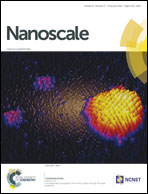Controlling the growth of porphyrin based nanostructures for tuning third-order NLO properties†
Abstract
A series of porphyrin nanospindles with controlled long axis length distributions of 330, 550, 800 nm, and 4 μm have been successfully fabricated via hierarchical self-assembly of cationic porphyrin (H6TPyP)4+ with the help of anionic surfactant sodium dodecyl sulfonate (SDS) due to the effective electrostatic interaction. These newly fabricated nanostructures are characterized by TEM and SEM techniques, powder X-ray diffraction analysis, electronic absorption spectroscopy, and confocal laser scanning microscopy (CLSM). The Z-scan technique with a laser duration of 5 ns at the wavelength of 532 nm reveals unreported size-dependent third-order NLO switching properties: the nonlinear absorption changes from saturation absorption to reversed saturation absorption and the nonlinear refraction from self-defocus to self-focus due to the change of the dominant scattering effect, from Rayleigh scattering for nanostructures with a smaller size than the wavelength of laser light, to Mie scattering for nanostructures with a larger size than the laser wavelength. This result is useful for the development of organic nanostructures with desired NLO properties, in particular the optical limiting properties.


 Please wait while we load your content...
Please wait while we load your content...